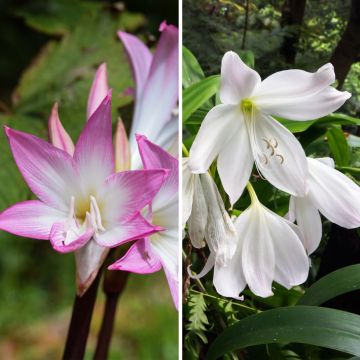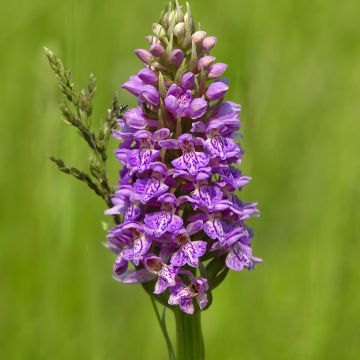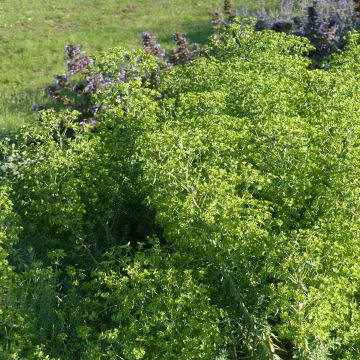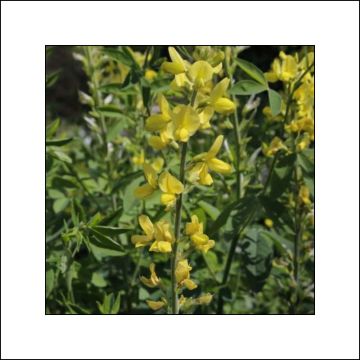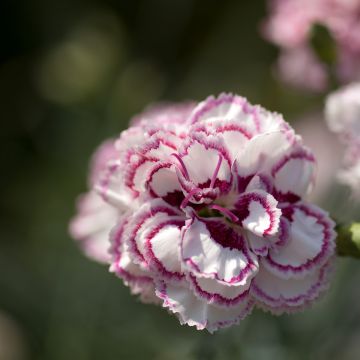

Cypripedium Inge - Lady Slipper Orchid
Cypripedium Inge - Lady Slipper Orchid
Cypripedium parviflorum (x) fasciolatum Inge
Yellow Lesser Lady's Slipper
This item cannot be shipped to the selected country
Delivery charge from €5.90
More information
Schedule delivery date,
and select date in basket
This plant carries a 12 months recovery warranty
More information
We guarantee the quality of our plants for a full growing cycle, and will replace at our expense any plant that fails to recover under normal climatic and planting conditions.
From €5.90 for pickup delivery and €6.90 for home delivery
Express home delivery from €8.90.
Does this plant fit my garden?
Set up your Plantfit profile →
Description
The 'Inge' Cypripedium is a hybrid Lady's Slipper Orchid with flowers of quite unusual colours. On foliage of rich green with silver undersides, this very hardy garden orchid, capable of withstanding temperatures as low as -30°C, develops a flower with long twisted brownish-red petals tinged with green, crowning a swollen cream-yellow lip tinged with red on the inside. Flowering lasts a long time for this variety, three weeks from mid-May. To acclimate it to the garden, provide it with shady or semi-shady exposure and sandy and humus-bearing soil, slightly acidic, remaining somewhat moist but not waterlogged.
The 'Inge' Cypripedium belongs to the orchid family and is the result of cross-breeding between the Cypripedium parviflorum var. parviflorum and the Cypripedium fasciolatum. The first parent is native to North America, from eastern Nebraska and Oklahoma to eastern Virginia and New Hampshire. It grows in bogs, wetlands, coastlines, and moist forests. The second parent is native to the mountainous province of Sichuan in China and is very rare in nature.
The 'Inge' Cypripedium develops from a fleshy stump from which light green, oval, elliptical leaves emerge in early spring, measuring 12 cm in length, sessile and embracing, with strongly impressed parallel veins.—the stump slightly suckers, allowing it to form beautiful colonies eventually in late spring, around May-June, and for about three weeks, the plants produce beautiful hairy flower stems, sometimes reaching 80 cm or 1 m above the ground. Each stem bears a solitary flower. The slender flower has twisted sepals and petals, is purplish-brown with green spots, and has a large swollen cream-yellow lip. Each plant is usually uniflorous. The above-ground vegetation is absent in winter.
The 'Inge' Cypripedium is a perfectly hardy variety that multiplies rapidly in pots and gardens as long as the conditions are suitable. It thrives in forest edges, preferring a light soil that retains some moisture without being waterlogged. Plant it in a location with not too intense shade, in a cool rockery, an ideal habitat for it to thrive and beautify your garden with its unique presence. Accompany it with a simple fern like Polypodium vulgare and the flowering of Trilliums and Lamium orvala. It also thrives in containers and unheated greenhouses. It is a plant that dislikes heat, drought, and strong winds.
When you receive your orchids, handle them with care: these plants produce few roots and are delicate!
Report an error about the product description
Flowering
Foliage
Plant habit
Botanical data
Cypripedium
parviflorum (x) fasciolatum
Inge
Orchidaceae
Yellow Lesser Lady's Slipper
Cultivar or hybrid
Other Garden Orchids
Planting and care
Plant Cypripedium Inge in part-shade, light, lime-free, acidic, always slightly moist soil. This garden orchid does not tolerate heavy, soggy, poorly drained soil or drought. When planting, mix 1/3 peat moss and 1/3 non-limestone fine gravel (coarse sand or pozzolan) with topsoil and leaf compost. Water the plant lightly, keeping the soil slightly moist in summer. Protect the stump for the first year with 10 cm of leaf litter. Cypripediums do not like fertiliser. Avoid direct sunlight at the hottest times of the day.
Planting period
Intended location
Care
This item has not been reviewed yet - be the first to leave a review about it.
Spring flowering perennials
Haven't found what you were looking for?
Hardiness is the lowest winter temperature a plant can endure without suffering serious damage or even dying. However, hardiness is affected by location (a sheltered area, such as a patio), protection (winter cover) and soil type (hardiness is improved by well-drained soil).

Photo Sharing Terms & Conditions
In order to encourage gardeners to interact and share their experiences, Promesse de fleurs offers various media enabling content to be uploaded onto its Site - in particular via the ‘Photo sharing’ module.
The User agrees to refrain from:
- Posting any content that is illegal, prejudicial, insulting, racist, inciteful to hatred, revisionist, contrary to public decency, that infringes on privacy or on the privacy rights of third parties, in particular the publicity rights of persons and goods, intellectual property rights, or the right to privacy.
- Submitting content on behalf of a third party;
- Impersonate the identity of a third party and/or publish any personal information about a third party;
In general, the User undertakes to refrain from any unethical behaviour.
All Content (in particular text, comments, files, images, photos, videos, creative works, etc.), which may be subject to property or intellectual property rights, image or other private rights, shall remain the property of the User, subject to the limited rights granted by the terms of the licence granted by Promesse de fleurs as stated below. Users are at liberty to publish or not to publish such Content on the Site, notably via the ‘Photo Sharing’ facility, and accept that this Content shall be made public and freely accessible, notably on the Internet.
Users further acknowledge, undertake to have ,and guarantee that they hold all necessary rights and permissions to publish such material on the Site, in particular with regard to the legislation in force pertaining to any privacy, property, intellectual property, image, or contractual rights, or rights of any other nature. By publishing such Content on the Site, Users acknowledge accepting full liability as publishers of the Content within the meaning of the law, and grant Promesse de fleurs, free of charge, an inclusive, worldwide licence for the said Content for the entire duration of its publication, including all reproduction, representation, up/downloading, displaying, performing, transmission, and storage rights.
Users also grant permission for their name to be linked to the Content and accept that this link may not always be made available.
By engaging in posting material, Users consent to their Content becoming automatically accessible on the Internet, in particular on other sites and/or blogs and/or web pages of the Promesse de fleurs site, including in particular social pages and the Promesse de fleurs catalogue.
Users may secure the removal of entrusted content free of charge by issuing a simple request via our contact form.
The flowering period indicated on our website applies to countries and regions located in USDA zone 8 (France, the United Kingdom, Ireland, the Netherlands, etc.)
It will vary according to where you live:
- In zones 9 to 10 (Italy, Spain, Greece, etc.), flowering will occur about 2 to 4 weeks earlier.
- In zones 6 to 7 (Germany, Poland, Slovenia, and lower mountainous regions), flowering will be delayed by 2 to 3 weeks.
- In zone 5 (Central Europe, Scandinavia), blooming will be delayed by 3 to 5 weeks.
In temperate climates, pruning of spring-flowering shrubs (forsythia, spireas, etc.) should be done just after flowering.
Pruning of summer-flowering shrubs (Indian Lilac, Perovskia, etc.) can be done in winter or spring.
In cold regions as well as with frost-sensitive plants, avoid pruning too early when severe frosts may still occur.
The planting period indicated on our website applies to countries and regions located in USDA zone 8 (France, United Kingdom, Ireland, Netherlands).
It will vary according to where you live:
- In Mediterranean zones (Marseille, Madrid, Milan, etc.), autumn and winter are the best planting periods.
- In continental zones (Strasbourg, Munich, Vienna, etc.), delay planting by 2 to 3 weeks in spring and bring it forward by 2 to 4 weeks in autumn.
- In mountainous regions (the Alps, Pyrenees, Carpathians, etc.), it is best to plant in late spring (May-June) or late summer (August-September).
The harvesting period indicated on our website applies to countries and regions in USDA zone 8 (France, England, Ireland, the Netherlands).
In colder areas (Scandinavia, Poland, Austria...) fruit and vegetable harvests are likely to be delayed by 3-4 weeks.
In warmer areas (Italy, Spain, Greece, etc.), harvesting will probably take place earlier, depending on weather conditions.
The sowing periods indicated on our website apply to countries and regions within USDA Zone 8 (France, UK, Ireland, Netherlands).
In colder areas (Scandinavia, Poland, Austria...), delay any outdoor sowing by 3-4 weeks, or sow under glass.
In warmer climes (Italy, Spain, Greece, etc.), bring outdoor sowing forward by a few weeks.


































